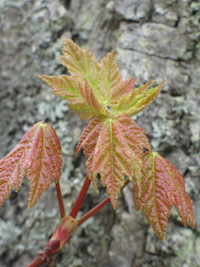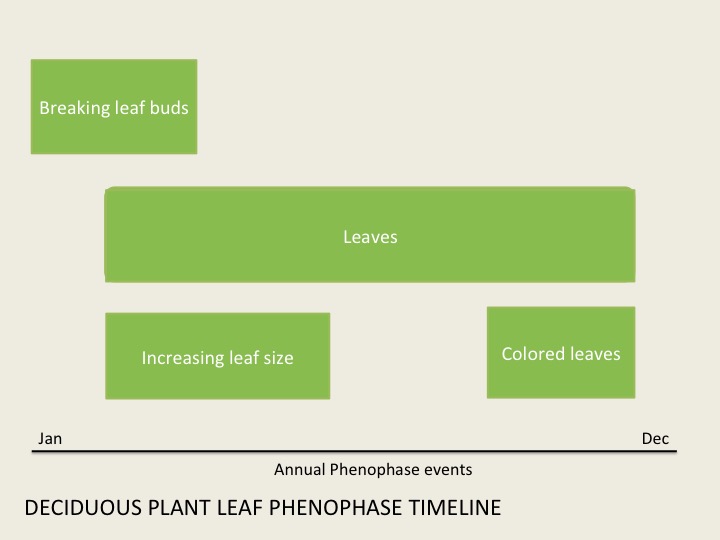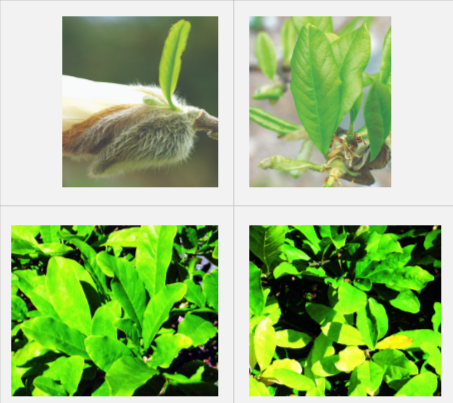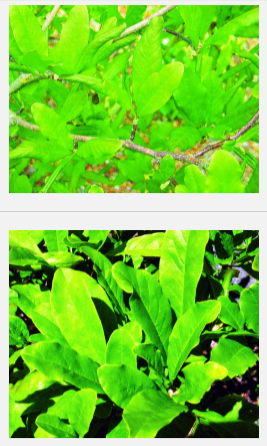#7 in the Nugget Series
Help! The phenophases are coming too fast! Part 1: Leaves
by Patty Guertin
May 10, 2016
Last updated 10/18/23

There is a lot going on with my plant. How do I make sense of it all?
A plant, even a small one, can have lots of activity occurring during the growing season. This visual complexity can make it difficult to understand when a phenophase has begun or ended. When observing for Nature’s Notebook, look only at the plant parts in the phenophase definition, and evaluate those individual parts separately over the entire plant. With focus on the defintion, it should be easier to determine whether any phenophase question deserves a "yes" or a "no" response.
For each Nature’s Notebook plant species, we ask you to answer questions from a set of phenophase definitions which have been carefully developed by USA-NPN staff. Each question is meant to capture a specific phase of a plant’s biological behavior. Your task is to gather an accurate account of what your plant is doing each time you go out to record observations. The more observations available for an individual plant through time, the better story the data will tell for someone who is interested in the data as an end-user, especially if they are studying the plant from afar.
In this segment, we offer a few suggestions to not only make the task easier, but to improve observation and data accuracy. We have all had difficulty at times sorting through confusing plant cues—so getting familiar with the plant you have chosen, taking a bit of time to practice making observations if it is new and unfamiliar, and focusing closely on the phenophase definition will all contribute to rendering more accurate observations.
Start by taking a minute or two to look over your plant to get an overview of what is happening—are there leaf buds? leaves? flowers buds? flowers? unripe fruits? ripe fruits? Next, mentally step back and begin your observation time by carefully reading a phenophase definition to focus solely on the activity or behavior being asked about. Each question has some key words that will help to make the task easier if you focus on those keywords/cues. Keeping those cues in mind, look at your plant again, observing only the plant parts and cues a phenophase question is asking about; assess those plant parts individually to determine their current status.
If you are being asked about the "Breaking leaf buds" phenophase, you would ignore all other leaf activity and behaviors on the plant to specifically answer the questions concerning only the leaf buds. You would carefully observe whether or not a few, or most, of the previously dormant and swelling leaf buds have developed and moved into the "Breaking leaf buds" phase but have not yet unfolded their leaves, and report accordingly. Remember, answering "no" to a phenophase question is equally as important as answering "yes"! A "no"—just as a "yes"—will also signal to a researcher or a manager important and useful information regarding the beginning and ending of each phenophase, environmental responses and the ongoing development of the plant.
Lets do a quick overview of a few of the leaf phenophases to understand how a participant might approach their observation time, understand the primary cues for a phenophase, and determine beginning and end points of a phenophase:
BREAKING LEAF BUDS
Let's focus first on the phenophase "Breaking leaf buds." Its definition, found on the species’ profile webpage for a relevant species, reads:
One or more breaking leaf buds are visible on the plant. A leaf bud is considered "breaking" once a green leaf tip is visible at the end of the bud, but before the first leaf from the bud has unfolded to expose the leaf base at its point of attachment to the leaf stalk (petiole) or stem.
Pick out some keywords that might be helpful to you and would serve to support a visual cue for you. I have chosen leaf bud, green leaf tip visible, and before the first leaf has unfolded. It may be helpful to take time before making Nature’s Notebook observations to be clear about difficult terminology and plant growth activities, such as what an "unfolded leaf" looks like, especially on your plant. For assistance, use the USA-NPN's Botany Primer! Then, take some time to practice on your plant.
Next, you would look over their entire plant to notice if there were any leaf buds or leaf activity that fit the cues in the description. As a phenophase becomes active on your plant, more and more plant parts may be engaged in the same phenological activity each time you visit. Typically, as time passes, fewer plant parts will remain in any particular phenophase, but as long as just one plant part fits any specific definition, you will report "yes" until that singular plant part has completed the defined phenophase. As the definition of "Breaking leaf buds" states, the endpoint for reporting "yes" for this phenophase—and the point at which you begin reporting "no"—would be when each of the leaf buds on the plant have unfolded their first leaf.

Leaf buds have quite a bit of variety depending on the species being observed. The photos on the left show a magnolia that has two types of buds containing leaves: buds that contain only leaves and buds that contain both leaves and flowers. The first two images show a bud that contains only leaves; the first image shows a breaking bud and the second image the leaf bud as the first leaf becomes unfolded.
The third and fourth images show a bud containing both leaves and a flower. In the case of mixed buds, when observing for "Breaking leaf buds", you would pay attention only to the leaf or leaves. The third image shows an emerging leaf along with the emerging flower. The fourth image shows an unfolded leaf with the developing flower (partially cut off).
If you estimate that all of the buds on your plant look like the second and fourth images (which have leaf stalks visible), you would report "no" for the "Breaking leaf buds" phenophase during your visit to the plant, including those mixed with flower buds and flowers.
A note on overlapping phenophases
When you take a few minutes to get an overview of activity for their plant at the outset of taking observations for Nature’s Notebook, you could notice several phenological activities going on with your plant at the same time. It might be flowering at the same time the leaf buds are breaking, or the unfolded leaves are steadily increasing in size but haven’t reached their full size. In some species, fruit can be developing as the leaf buds are breaking.
Overlapping phenophases can be confusing, especially when those phenophases involve the same plant parts. Remember, you can report yes for multiple phenophases at the same time, so it is perfectly fine to report "yes" for only one of the leaf phenophases - with the exception of the "Leaves" phenophase (explained below), the phases are not dependent upon each other and may or may not happen at the same time depending upon your species.
As an example, let’s consider some potentially overlapping phenophases for leaves.

LEAVES
While you are still reporting "yes" to the "Breaking leaf buds" phenophase on your plant, you could also be answering "yes" to the "Leaves" phenophase or the "Young leaves" phenophase or the "Increasing leaf size" phenophase. The specific phenophase definition for a plant depends on the species of plant—and will be listed on the plant’s species profile webpage. This is where a very focused approach to a phenophase definition, as we are describing, is important while observing your plant.
The "Leaves" phenophase, when the definition is read carefully, is all-inclusive for all live leaves that have unfolded—young leaves to mature to those turning colors. The four images to the left illustrate all the phases in which the leaves on your plant could be active when reporting "yes" for this phenophase because all of those are considered "Leaves." The definition:
One or more live, unfolded leaves are visible on the plant. A leaf is considered "unfolded" once its entire length has emerged from a breaking bud, stem node or growing stem tip, so that the leaf base is visible at its point of attachment to the leaf stalk (petiole) or stem. Do not include fully dried or dead leaves.

Therefore, you would look over your plant and all its leaves—and focus on the leaves that have unfolded and are alive. You would report "yes" for this phenophase, as long as one leaf remains on the plant that fits this definition.
Note that the phenophases for "Young leaves", "Increasing leaf size" and "Colored leaves" include live, unfolded leaves still attached to the plant and are therefore all nested within the "Leaves" phenophase. If you report "yes" to any of those phenophases, you should also be reporting "yes" for "Leaves".
INCREASING LEAF SIZE
Next, you might be assessing your plant for "Increasing leaf size" phenophase observations—another potentially overlapping phenophase. The phenophase definition is:
A majority of leaves on the plant have not yet reached their full size and are still growing larger. Do not include new leaves that continue to emerge at the ends of elongating stems throughout the growing season.

First, having some familiarity with what a full size leaf looks like on your plant is important for reporting on this phenophase. Then check over your plant: of all the unfolded leaves on your plant, are any less than full size? How many? More than half of the leaves on your plant (remember... a majority is asked for)? For the images on the left: the top image shows that most leaves on this plant are increasing in size and you would report "yes" to the "Increasing leaf size" phenophase. The image at the bottom that shows the plant with full sized leaves for this species. It may have a few leaves still increasing in size, but no longer has a majority of its leaves increasing in size. Once the plant has reached this status, you would report "no" to the "Increasing leaf size" phenophase for the plant.
You might apply a similar approach to all the phenophase definitions while making observations for your plant. A plant engaged in many phenological activities at one time can be very confusing. So, take it slow and get an overview, assess your plant’s activity, focus on your plant’s phenophase definitions, evaluate the definition's plant parts individually, and mostly, enjoy getting to know your plant species as you record observations for Nature’s Notebook.
Based on what you have learned above, how would you know when to stop reporting "yes" for colored leaves, based on the phenophase defintion below?
One or more leaves show some of their typical late-season color, or yellow or brown due to drought or other stresses. Do not include small spots of color due to minor leaf damage, or dieback on branches that have broken. Do not include fully dried or dead leaves that remain on the plant.
When the leaves have either fallen off the plant or have turned fully dried, or dead.
In the next Nugget, we will focus on the flower and fruit phenophases...
Enjoy! making your Nature's Notebook observations this spring... and thank you so much for participating!